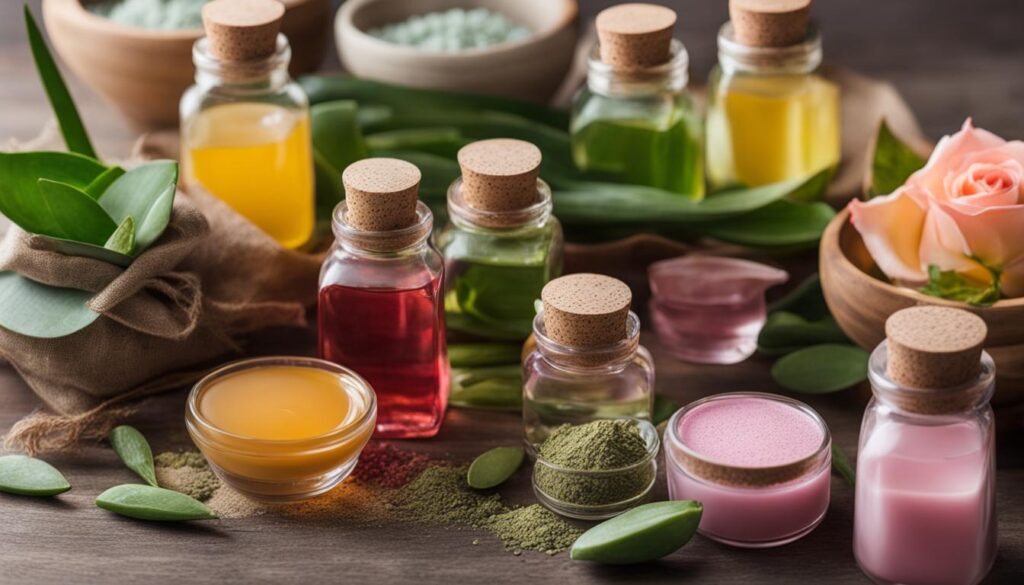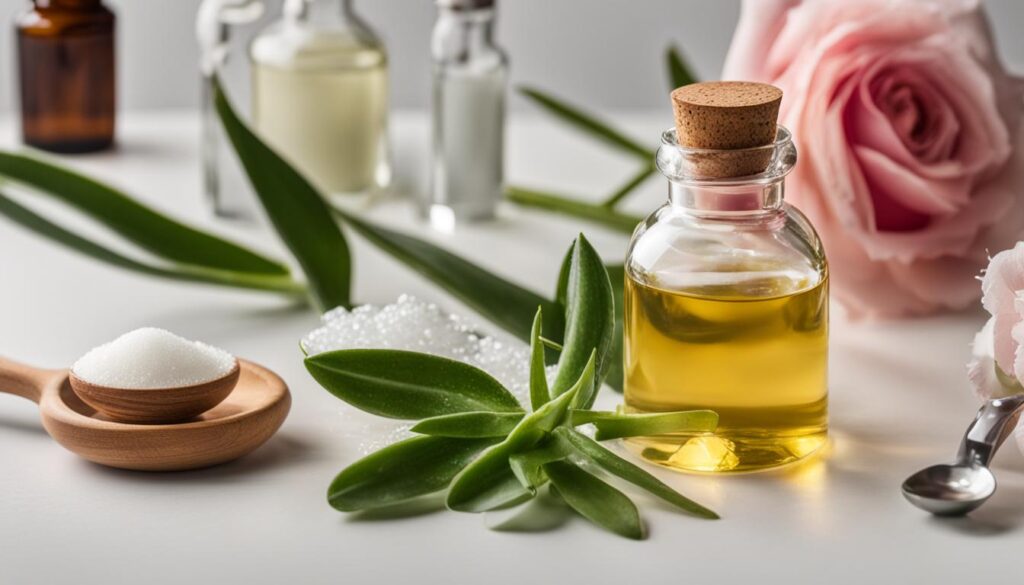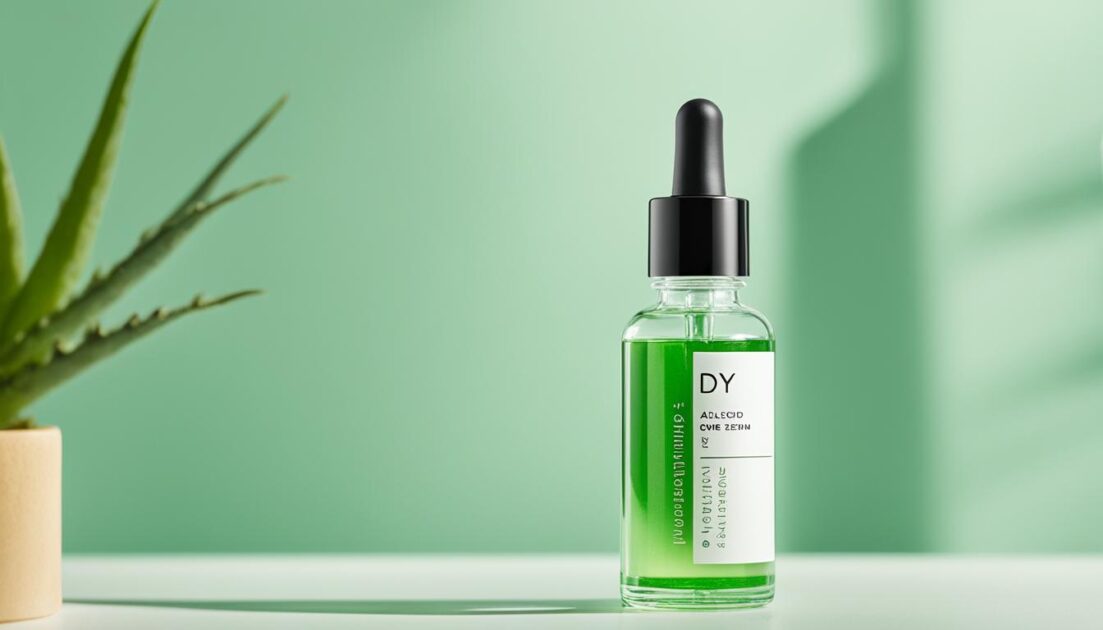In this DIY guide, I will show you how to make your own hyaluronic acid serum at home. Hyaluronic acid is a natural substance that is already present in our bodies, and it plays a crucial role in keeping our skin hydrated and plump. By making your own serum, you can customize the ingredients to suit your skin’s needs and reap the benefits of this incredible skincare ingredient.
Key Takeaways:
- Learn how to make hyaluronic acid serum at home with this DIY guide.
- Customize the ingredients to suit your skin’s needs.
- Hyaluronic acid helps keep the skin hydrated and plump.
- Use the serum twice a day for best results.
- Suitable for all skin types, including sensitive skin.
Understanding the Benefits of Hyaluronic Acid for Skin
Hyaluronic acid is a powerful ingredient that offers numerous benefits for the skin. Its ability to retain moisture makes it an essential component of skincare routines worldwide. Let’s explore the remarkable advantages that hyaluronic acid provides and why it is a popular choice for skincare enthusiasts.
Improved Skin Hydration
One of the primary benefits of hyaluronic acid is its exceptional hydrating properties. By attracting moisture from the environment and binding it to the skin, hyaluronic acid helps maintain optimal hydration levels. This ensures that the skin remains well-nourished, plump, and rejuvenated.
Reduced Signs of Aging
Fine lines and wrinkles are a natural part of the aging process. However, hyaluronic acid can help minimize their appearance. Its ability to retain moisture boosts skin elasticity, reducing the visibility of wrinkles and giving the skin a smoother and more youthful look.
Enhanced Skin Texture
Hyaluronic acid works wonders for improving the overall texture of the skin. By hydrating and plumping the skin, it helps reduce roughness and unevenness. This results in a smoother, softer, and more supple complexion.
Increased Skin Elasticity
As we age, the skin can lose its natural elasticity, leading to sagging and drooping. Hyaluronic acid helps counteract this by maintaining the skin’s moisture levels, promoting firmness, and enhancing elasticity. This gives the skin a more lifted and youthful appearance.
Suitable for All Skin Types
Whether you have oily, dry, or sensitive skin, hyaluronic acid is a versatile ingredient suitable for all skin types. Its lightweight and non-comedogenic nature make it gentle and non-irritating, making it an excellent choice for those with sensitive skin.
To truly grasp the benefits of hyaluronic acid, a comprehensive understanding of its effects is crucial. By incorporating hyaluronic acid into your skincare routine, you can enjoy hydrated, plump, and rejuvenated skin that radiates natural beauty.

The Science behind DIY Hyaluronic Acid Serum
Hyaluronic acid serum plays a crucial role in maintaining the skin’s hydration and moisture levels. When applied topically, it creates a protective barrier on the skin’s surface, preventing excessive water loss and helping to keep the skin hydrated and supple.
Hyaluronic acid is a natural substance produced by our bodies, primarily in the skin. It has the remarkable ability to attract and hold onto water molecules, making it an essential component for maintaining optimal skin hydration. However, as we age, our natural hyaluronic acid production begins to decline, leading to dryness, fine lines, and a loss of elasticity.
“Hyaluronic acid serum helps to replenish the skin’s natural hyaluronic acid levels and promote a youthful, plump appearance.”
By incorporating a DIY hyaluronic acid serum into your skincare routine, you can control the ingredients and create a customized product that addresses your skin’s specific needs. This allows you to enhance the skin’s hydration levels and improve its overall health and appearance.
The process of making hyaluronic acid serum involves combining hyaluronic acid powder with other beneficial ingredients like distilled water, vegetable glycerin, aloe vera gel, and vitamin E oil. These ingredients work together to boost the moisturizing and nourishing properties of the serum, providing a rejuvenating effect on the skin.
Not only does DIY hyaluronic acid serum deliver intense hydration to the skin, but it also promotes collagen production, reduces the appearance of fine lines and wrinkles, and improves skin elasticity. Its lightweight and non-greasy texture make it suitable for all skin types, including sensitive skin.
When applying hyaluronic acid serum, it’s important to apply it to clean, damp skin and follow it with a moisturizer to seal in the hydration. You can also mix a few drops of the serum into your favorite moisturizer to enhance its hydrating benefits. For best results, use the serum twice a day, in the morning and at night.
Benefits of DIY Hyaluronic Acid Serum:
- Intensely hydrates the skin
- Improves skin elasticity
- Reduces the appearance of fine lines and wrinkles
- Promotes a plump and youthful complexion
- Enhances overall skin health
- Suitable for all skin types
By harnessing the power of hyaluronic acid production and creating your own DIY hyaluronic acid serum, you can experience the benefits of this natural skincare ingredient and achieve a radiant, glowing complexion.
Ingredients Required for Making Hyaluronic Acid Serum at Home
When it comes to making your own hyaluronic acid serum, you’ll need a few key ingredients that contribute to the hydration and plumping of the skin. Here’s a breakdown of the essential components:
Hyaluronic Acid Powder
Starting with the star ingredient, hyaluronic acid powder, which provides intense hydration and helps improve the appearance of fine lines and wrinkles.
Distilled Water
Distilled water is crucial for creating a pure and sterile environment for your DIY serum. It ensures that no impurities or contaminants interfere with the effectiveness of the ingredients.
Vegetable Glycerin
Vegetable glycerin acts as a natural humectant, attracting moisture to the skin and preventing moisture loss. It helps to keep your skin soft and supple.
Aloe Vera Gel
Aloe vera gel is known for its soothing and moisturizing properties. It helps to calm irritated skin and provides an additional layer of hydration.
Vitamin E Oil
Vitamin E oil is a powerful antioxidant that helps protect the skin from oxidative damage. It also aids in moisturizing and nourishing the skin, leaving it smooth and radiant.
Combining these carefully selected ingredients will allow you to create a customized hyaluronic acid serum that addresses the specific needs of your skin.
Now that we’ve covered the essential ingredients, let’s move on to a step-by-step guide on how to make your own hyaluronic acid serum at home.

Step-by-Step Guide to Making Hyaluronic Acid Serum
Interested in making your own hyaluronic acid serum at home? It’s easier than you think! Just follow these simple steps:
-
Dissolve hyaluronic acid powder in distilled water to create the base of your serum. Use a ratio of 1% hyaluronic acid powder to distilled water for best results. Stir the mixture until the powder is completely dissolved.
-
Mix vegetable glycerin, aloe vera gel, and a few drops of vitamin E oil together in a separate bowl. Vegetable glycerin helps to lock in moisture, while aloe vera gel and vitamin E oil provide additional nourishment and hydration to the skin.
-
Combine the hyaluronic acid mixture with the glycerin mixture, and stir well to ensure all the ingredients are thoroughly mixed. This will create a potent and effective hyaluronic acid serum.
-
Transfer the serum to a dark glass bottle with a dropper for easy application and to preserve the potency of the ingredients. Dark glass bottles help to protect the serum from light exposure, which can degrade its effectiveness over time.
And that’s it! You now have your homemade hyaluronic acid serum ready to use and enjoy the benefits of hyaluronic acid for your skin. Remember to store the serum in a cool, dry place to extend its shelf life.

Here’s a comparison table of store-bought vs. homemade hyaluronic acid serum:
| Factors | Store-Bought Hyaluronic Acid Serum | Homemade Hyaluronic Acid Serum |
|---|---|---|
| Cost | Generally higher due to brand markup | More cost-effective as you can control the ingredients |
| Customizability | Limited options | You can choose ingredients based on your skin’s specific needs |
| Purity of Ingredients | May contain additional fillers or preservatives | You have full control over the quality and purity of the ingredients |
| Freshness | Shelf life determined by the manufacturer | You can make smaller batches for maximum freshness |
| Effectiveness | May vary based on the brand and formulation | You can adjust the concentration of hyaluronic acid to suit your skin’s needs |
Incorporating Hyaluronic Acid Serum into Your Skincare Routine
Properly incorporating hyaluronic acid serum into your skincare routine is key to reaping its full benefits. Follow these simple steps to ensure maximum effectiveness:
-
Cleanse and Tone: Begin by cleansing your face with a gentle cleanser suitable for your skin type. This will remove any dirt, oil, or impurities.
-
Apply Hyaluronic Acid Serum: After cleansing, take a few drops of hyaluronic acid serum and gently massage it onto your face and neck. Focus on areas that may require extra hydration or are prone to dryness or wrinkles.
-
Mix with Moisturizer: For an added boost of hydration, you can mix a few drops of the serum into your favorite moisturizer. This will enhance its moisturizing properties and ensure deep hydration.
-
Moisturize: After applying the hyaluronic acid serum, follow it up with a moisturizer suitable for your skin type. This will help seal in the serum and provide additional hydration to your skin.
-
Apply Twice a Day: For optimal results, incorporate hyaluronic acid serum into your morning and nighttime skincare routines. This will provide consistent hydration and plumping effects throughout the day and overnight.
“Hyaluronic acid serum is a powerful addition to any skincare routine. Its ability to attract and retain moisture can help hydrate and plump the skin, reducing the appearance of fine lines and wrinkles. By following these steps, you can maximize the benefits of hyaluronic acid for healthier, more radiant skin.”
By following these simple steps, you can make the most out of your hyaluronic acid serum and achieve the desired results. Remember to be consistent and patient, as skincare results often take time. With regular use, you’ll likely notice improvements in your skin’s hydration, texture, and overall appearance.
| Benefits of Incorporating Hyaluronic Acid Serum into Your Skincare Routine | Steps to Incorporate Hyaluronic Acid Serum | |
|---|---|---|
|
|
|
Hyaluronic Acid Serum for Different Skin Types
Hyaluronic acid serum is a versatile skincare product that is suitable for all skin types, including sensitive skin. Whether you have oily, dry, or combination skin, incorporating hyaluronic acid serum into your skincare routine can provide numerous benefits for your complexion.
If you have oily skin, you may choose to pair the hyaluronic acid serum with a lighter moisturizer. This can help balance the hydration levels of your skin without adding excess oil or heaviness. By using a light moisturizer, you can ensure that your skin feels nourished without clogging the pores or causing any greasiness.
On the other hand, if you have dry skin, the hyaluronic acid serum can be used as a standalone moisturizer. Its powerful hydrating properties can help replenish moisture levels in the skin and reduce the appearance of dryness or flakiness. By using the serum as a standalone moisturizer, you can ensure that your skin stays hydrated and plump throughout the day.
Regardless of your skin type, incorporating hyaluronic acid serum into your skincare routine can promote a healthier and more youthful-looking complexion. Its ability to attract and retain moisture in the skin can improve overall hydration, reduce the appearance of fine lines and wrinkles, and enhance skin elasticity. By using hyaluronic acid serum regularly, you can enjoy the benefits of this powerhouse ingredient and achieve optimal skincare results.
FAQ
What are the benefits of hyaluronic acid for the skin?
Hyaluronic acid helps keep the skin hydrated, plump, and youthful-looking. It can improve skin texture, reduce the appearance of fine lines and wrinkles, and increase skin elasticity.
How does hyaluronic acid serum work?
When applied topically, hyaluronic acid serum forms a barrier on the skin’s surface, preventing moisture loss and keeping the skin hydrated. It attracts and retains moisture in the skin, giving it a plump and hydrated appearance.
What ingredients do I need to make a hyaluronic acid serum at home?
To make a DIY hyaluronic acid serum, you will need hyaluronic acid powder, distilled water, vegetable glycerin, aloe vera gel, and vitamin E oil.
How do I make a hyaluronic acid serum at home?
To make a DIY hyaluronic acid serum, dissolve hyaluronic acid powder in distilled water, mix vegetable glycerin, aloe vera gel, and vitamin E oil, combine the hyaluronic acid mixture with the glycerin mixture, and transfer the serum to a dark glass bottle with a dropper.
How should I incorporate hyaluronic acid serum into my skincare routine?
Use the hyaluronic acid serum after cleansing and toning your skin, and before applying moisturizer. You can also mix a few drops of the serum into your moisturizer for added hydration. Use the serum twice a day, in the morning and at night, for best results.
Is hyaluronic acid serum suitable for all skin types?
Yes, hyaluronic acid serum is suitable for all skin types, including sensitive skin.
What should I do if I have oily skin?
If you have oily skin, you may want to use a lighter moisturizer after applying the serum.
What should I do if I have dry skin?
If you have dry skin, you can use the hyaluronic acid serum as a standalone moisturizer.






